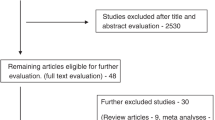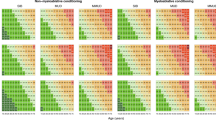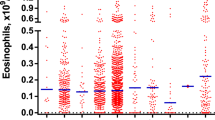Summary:
Although eosinophilia after stem cell transplantation (SCT) has been addressed in recent reports, the significance of eosinophilia in disease outcome after SCT has not been well studied. In this study, we investigate the frequency of eosinophilia after SCT to determine its prognostic value. The subjects were 113 patients with malignant or nonmalignant diseases who underwent SCT treatment. In these patients, eosinophilia was detected in 44 cases (38.9%), on average 67.5 days after transplantation, and the mean maximum absolute eosinophil count was 840.5 × 106/l. To study the basis of eosinophilia after SCT, various serum cytokine levels during SCT in patients both with and without eosinophilia were analyzed. Statistical analysis indicated that the overall patient survival rates improved in those with eosinophilia compared to those without eosinophilia (88.7 vs 43.0%, P=0.0034). In particular, in patients with malignant diseases, those with eosinophilia showed a higher event-free survival (81.1 vs 44.6%, P=0.0025) and a lower relapse rate (16.0 vs 43.0%, P=0.0287) than those without eosinophilia. In conclusion, we propose that eosinophilia after SCT could be a useful prognostic marker for determining favorable outcomes in patients with malignant diseases. The reasons for this good prognosis in SCT patients with eosinophilia are discussed.
This is a preview of subscription content, access via your institution
Access options
Subscribe to this journal
Receive 12 print issues and online access
$259.00 per year
only $21.58 per issue
Buy this article
- Purchase on Springer Link
- Instant access to full article PDF
Prices may be subject to local taxes which are calculated during checkout


Similar content being viewed by others
References
Thomas E, Storb R, Clift R et al. Bone marrow transplantation É and ÉÉ. New Engl J Med 1975; 292: 832–843; 895–902.
Ringden O, Zwaan F, Hermans J, Gratwohl A . Transplantation for the Leukemia Working Party of the European Group for Bone Marrow Transplantation: European experience of bone marrow transplantation for leukemia. Transplant Proc 1987; 19: 2600.
Barrett AJ, Horowitz MM, Gale RP et al. Marrow transplantation for acute lymphoblastic leukemia: factors affecting relapse and survival. Blood 1989; 74: 862–871.
Appelbaum FR, Fisher LD, Thomas ED . Chemotherapy v marrow transplantation for adults with acute nonlymphocytic leukemia: a five-year follow-up. Blood 1988; 72: 179–184.
McNeel D, Rubio MT, Damaj G et al. Hypereosinophilia as a presenting sign of acute graft-versus-host disease after allogeneic bone marrow transplantation. Transplantation 2002; 74: 1797–1800.
Daneshpouy M, Socie G, Lemann M et al. Activated eosinophils in upper gastrointestinal tract of patients with graft-versus-host disease. Blood 2002; 99: 3033–3040.
Jacobsohn DA, Shechter T, Seshadri R et al. Eosinophilia correlates with the presence or development of chronic graft-versus-host disease in children. Transplantation 2004; 77: 1096–1100.
Basara N, Kiehl MG, Fauser AA . Eosinophilia indicates the evolution to acute graft-versus-host disease. Blood 2002; 100: 3055.
Przepiorka D, Weisdorf D, Martin P et al. 1994 Consensus Conference on Acute GVHD Grading. Bone Marrow Transplant 1995; 15: 825–828.
Atkinson K, Horowitz MM, Gale RP et al. Consensus among bone marrow transplanters for diagnosis, grading and treatment of chronic graft-versus-host disease. Committee of the International Bone Marrow Transplant Registry. Bone Marrow Transplant 1989; 4: 247–254.
Finella BB . The eosinophilias, including the idiopathic hypereosinophilic syndrome. Br J Haematol 2003; 121: 203–223.
Yang YG, Sergio JJ, Sykes M et al. Interleukin-12 preserves the graft-versus-host disease in mice. Blood 1997; 90: 4651–4660.
Maria-Grazia R, Manuela B, Silvia G . The role of interleukin 10 in the control of autoimmunity. J Autoimmun 2003; 20: 269–272.
Wang Z, Qiu SJ, Ye SL et al. Combined IL-12 and GM-CSF gene therapy for murine hepatocellular carcinoma. Cancer Gene Ther 2001; 8: 751–758.
Hill HC, Conway Jr TF, Sabel MS et al. Cancer immunotherapy with interleukin 12 and granulocyte–macrophage colony-stimulating factor-encapsulated microspheres; coinduction of innate and adaptive antitumor immunity and cure of disseminated disease. Cancer Res 2001; 62: 7254–7263.
Lissoni P, Fumagalli E, Malugani F et al. Stimulation of IL-12 secretion by GM-CSF in advanced cancer patients. J Biol Regul Homeost Agents 2001; 15: 163–165.
Imoto S, Oomoto Y, Murata K et al. Kinetics of serum cytokines after allogeneic bone marrow transplantation: interleukin-5 as a potential marker of acute graft-versus-host disease. Int J Hematol 2000; 72: 92–97.
Kalayciouglu ME, Bolwell BJ . Eosinophilia after allogeneic bone marrow transplantation using the busulfan and cyclophosphamide preparative regimen. Bone Marrow Transplant 1994; 14: 113.
Romero R, Abramowsky CR, Pillen T et al. Peripheral eosinophilia and eosinophilic gastroenteritis after pediatric liver transplantation. Pediatr Transplant 2003; 6: 484–488.
Alexandra HF, Judy VS, Sandra CT et al. Impact of donor type on outcome of bone marrow transplantation for Wiskott–Aldrich syndrome: collaborative study of the International Bone Marrow Transplant Registry and the National Marrow Donor Program. Blood 2001; 97: 1598–1603.
Author information
Authors and Affiliations
Corresponding author
Rights and permissions
About this article
Cite this article
Sato, T., Kobayashi, R., Nakajima, M. et al. Significance of eosinophilia after stem cell transplantation as a possible prognostic marker for favorable outcome. Bone Marrow Transplant 36, 985–991 (2005). https://doi.org/10.1038/sj.bmt.1705168
Received:
Accepted:
Published:
Issue Date:
DOI: https://doi.org/10.1038/sj.bmt.1705168
Keywords
This article is cited by
-
Chemokines and their receptors: predictors of the therapeutic potential of mesenchymal stromal cells
Journal of Translational Medicine (2021)
-
Elevated bone marrow eosinophil count is associated with high incidence of severe acute GvHD after allogeneic hematopoietic stem cell transplantation
Bone Marrow Transplantation (2017)
-
Eosinophilia predicts better overall survival after acute graft-versus-host-disease
Bone Marrow Transplantation (2010)
-
Blood eosinophilia after unrelated cord blood transplantation for adults
Bone Marrow Transplantation (2008)



